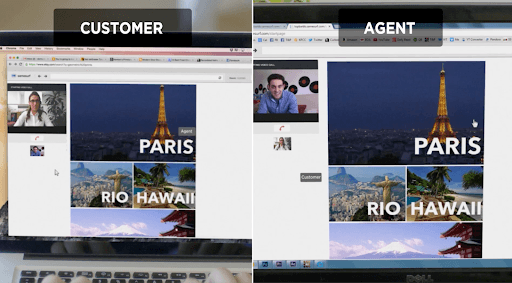Samesurf Co-Browsing for Law Firms
September 23, 2025

Samesurf invented modern co-browsing.
The legal profession, traditionally built on face-to-face interactions and reams of paper, is undergoing a profound digital transformation. While technology has brought unprecedented efficiency to legal research, case management, and internal operations, client-facing processes, particularly onboarding, often remain mired in complexity and outdated methods. New clients, navigating a bewildering array of legal documents, intake forms, and online portals, frequently feel overwhelmed and disconnected. This initial friction can erode trust, delay case progression, and ultimately impact the client’s perception of their legal representation.
Samesurf’s advanced co-browsing technology offers a powerful and intuitive solution to this critical challenge. More than just screen sharing, co-browsing creates a secure, shared digital environment where legal professionals can truly guide clients through complex web-based platforms and documents in real-time. This isn’t merely a convenience; it is rapidly becoming an essential tool for simplifying client onboarding, enhancing transparency, and building stronger, more confident client relationships in the digital age.
The Labyrinth of Legal Onboarding: A Barrier to Entry
For clients seeking legal services, the initial onboarding phase can be daunting. They are often facing stressful life events, and the necessity of completing intricate paperwork or understanding new digital systems only adds to their anxiety. Consider the typical pain points:
- Complex Digital Forms and Portals: Many law firms now utilize online intake forms or secure client portals for collecting information, sharing updates, and managing documents. While intended for efficiency, these platforms can be unintuitive for clients who are not tech-savvy or are simply overwhelmed by the volume of information required. A client might struggle to locate a specific section, correctly upload a document, or understand a legal term within the context of a form. The result is often an incomplete form, a delayed start to the case, or a frustrated phone call.
- Unpacking Dense Legal Documents: Whether it’s a retainer agreement, a privacy policy, or a complex power of attorney document, legal texts are inherently dense and filled with jargon. Simply emailing a document and asking a client to review it often leads to misunderstandings, unanswered questions, and a hesitant signature. Explaining these documents over a phone call requires the lawyer to refer to specific page numbers or paragraphs, making it difficult for the client to follow along visually.
- Security and Trust Concerns: Clients are increasingly wary of sharing sensitive personal and financial information online. When asked to navigate a new digital system or upload confidential documents, they need absolute assurance of security. Generic screen-sharing tools, which can expose an entire desktop, fall short of providing this necessary level of trust and privacy, especially in a profession bound by strict ethical and confidentiality rules.
- Inefficient Q&A Cycles: When a client has questions during the onboarding process, the traditional back-and-forth via email or phone can be incredibly time-consuming. Misinterpretations are common, and getting a clear, concise answer often requires multiple communications, delaying the critical initial steps of legal representation.
These challenges not only create inefficiency for law firms but, more importantly, can alienate new clients at a crucial juncture, potentially undermining the foundational relationship of trust.
Samesurf Co-Browsing: The Attorney’s Digital Compass
Samesurf’s co-browsing technology is specifically designed to eliminate these points of friction. It creates a secure, shared web session where both the legal professional and the client can view and interact with the same browser content in real-time. Unlike traditional screen sharing, Samesurf co-browsing focuses on the specific web page or application tab, providing granular control and robust security features that are paramount in the legal industry.
Here’s how Samesurf co-browsing transforms legal client onboarding:
1. Guiding Clients Through Complex Digital Intake Forms and Platforms
Imagine a new client needs to complete an intricate online intake form for a family law case, requiring detailed personal information, financial disclosures, and historical data.
- The Old Way: The firm sends a link to the online form. The client attempts to fill it out alone, gets stuck on sections related to asset declaration or child custody history, and then either abandons the form or calls the office with a series of fragmented questions. This leads to incomplete data, delays, and a frustrated client.
- The Samesurf Way: The legal assistant or attorney initiates a Samesurf co-browsing session with the client. Both parties see the same online intake form. The legal professional can verbally guide the client, saying, “Let’s start with Section 3, ‘Financial Disclosures.’ I’ll highlight the fields for your bank accounts.” Using Samesurf’s in-page control, the legal professional can use their cursor to point directly to specific fields, highlight required information, or even demonstrate how to upload a supporting document. With the client’s permission, the professional can even take temporary control of the mouse and keyboard to help the client navigate a dropdown menu or input basic, non-sensitive information, guiding them step-by-step through the process. This interactive approach ensures accuracy and significantly speeds up form completion.
2. Deciphering Dense Legal Documents in Real-Time
Clients often need help understanding the terms of service, a retainer agreement, or a critical consent form.
- The Old Way: The firm emails the document. The client reviews it alone, often feeling overwhelmed by the legal jargon, then calls with general questions. The attorney has to explain abstract concepts over the phone, hoping the client understands which specific clause they are referring to. This process is time-consuming and often leaves the client still feeling unsure.
- The Samesurf Way: During a consultation, the attorney and client open the legal document (e.g., a PDF in a web browser or a document within the firm’s client portal) in a co-browsing session. The attorney can navigate through the document page by page. “Let’s look at Paragraph 4, ‘Scope of Representation,'” the attorney might say, as their cursor highlights the exact text on the client’s screen. They can use Samesurf’s annotation tools to underline key clauses, circle important dates, or even type a simplified explanation directly next to a complex term. This visual, interactive explanation ensures clarity, builds client confidence, and significantly reduces the time spent on follow-up questions.
3. Enhancing Security and Trust for Sensitive Information
The legal industry operates under stringent confidentiality rules. Clients need to feel absolutely secure when sharing personal data.
- The Old Way: Asking a client to share their entire desktop via generic screen sharing for a document upload poses a significant risk. The attorney might inadvertently see other sensitive information on the client’s screen, violating privacy.
- The Samesurf Way: Samesurf’s patented technology allows for automatic redaction of sensitive fields. If a client is navigating a banking portal to retrieve a statement, or an insurance portal for policy details, Samesurf can be configured to block the agent’s view of specific sensitive data fields (e.g., account numbers, SSNs). The co-browsing session is confined to the specific tab, preventing accidental exposure of other open applications. This robust security provides peace of mind for both the client and the firm, ensuring compliance with privacy regulations and strengthening the attorney-client privilege.
4. Streamlining Case Management Portal Introductions
Many firms use client portals for ongoing case communication. Introducing a new client to this system can be challenging.
- The Old Way: The firm sends an email with login credentials and basic instructions. The client struggles to log in, upload documents, or find case updates, leading to calls to the firm’s reception and delays in information exchange.
- The Samesurf Way: During the initial consultation, after signing the retainer, the legal professional can initiate a co-browsing session to walk the client through their new client portal. They can demonstrate how to log in, navigate to different sections (e.g., “Documents,” “Messages,” “Billing”), upload files, and view case updates. This hands-on tutorial ensures the client is comfortable and proficient with the portal from day one, leading to smoother, more efficient ongoing communication.
The Indisputable Value: Why Co-Browsing is Essential
For the legal services industry, co-browsing isn’t merely a convenience; it’s an essential strategic tool that delivers multiple critical advantages:
- Increased Client Satisfaction and Retention: A smooth, clear, and supportive onboarding process makes clients feel valued and understood during what is often a stressful time. This positive initial experience builds loyalty and trust.
- Reduced Administrative Burden: By guiding clients efficiently through forms and portals, legal professionals reduce the time spent on repetitive clarifications, follow-up calls, and manual data entry errors. This frees up valuable time for core legal work.
- Improved Accuracy and Data Collection: Real-time guidance ensures that intake forms are completed accurately and completely on the first attempt, preventing delays caused by missing or incorrect information.
- Enhanced Transparency and Trust: Visually walking clients through documents and processes fosters transparency. Clients feel more informed and confident in their legal representation, knowing exactly what they are signing and what steps are being taken.
- Demonstrated Modernity and Professionalism: Adopting cutting-edge technology like Samesurf co-browsing showcases a law firm’s commitment to efficiency, client service, and digital innovation, setting them apart in a competitive market.
- Ensured Compliance and Security: With robust security features, law firms can maintain strict confidentiality and compliance standards while still providing a highly interactive digital experience.
In an era where digital presence and client experience are paramount, Samesurf co-browsing is no longer a luxury but an indispensable asset for law practices. It enables firms to bridge the digital divide, simplify the complexities of legal onboarding, and cultivate stronger, more productive client relationships right from the very first interaction.
Visit samesurf.com to learn more or go to https://www.samesurf.com/request-demo to request a demo today.


